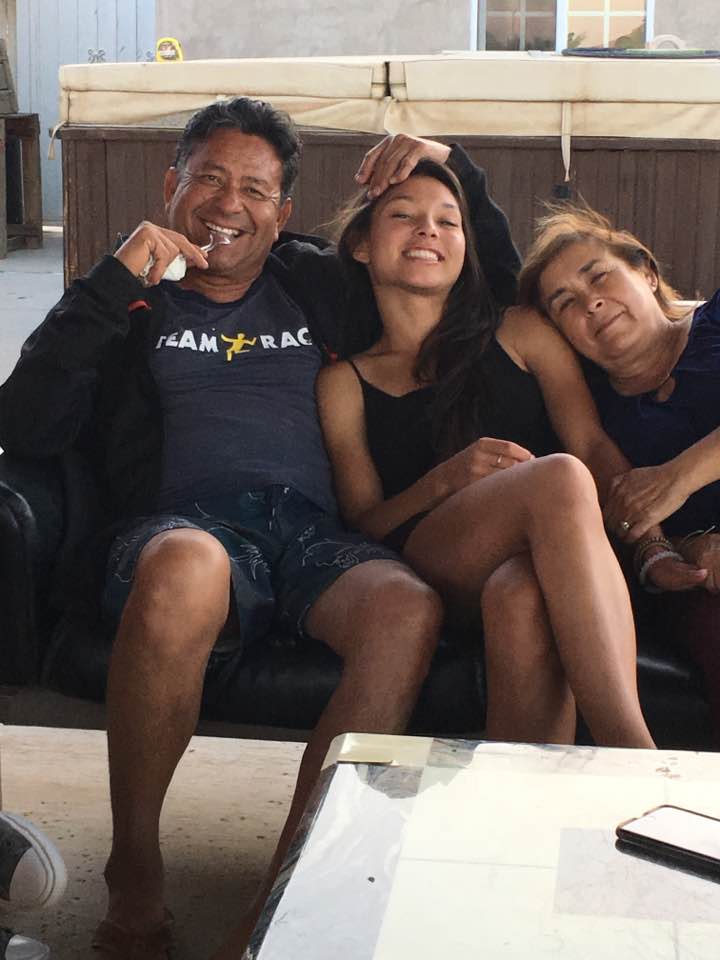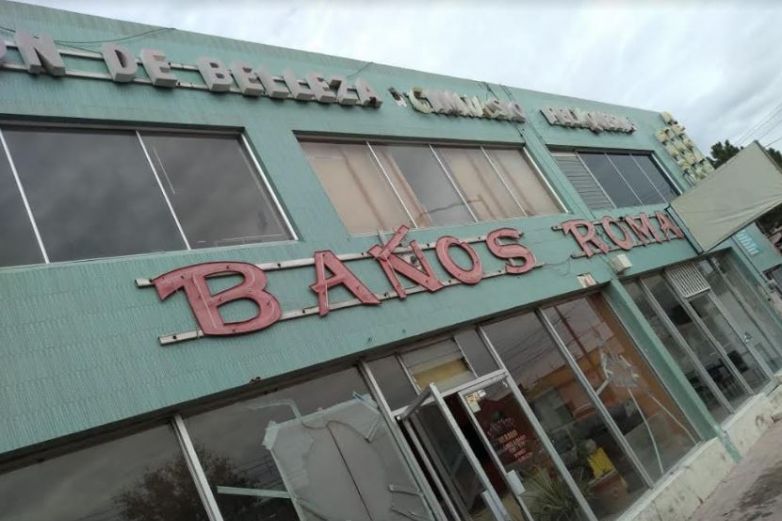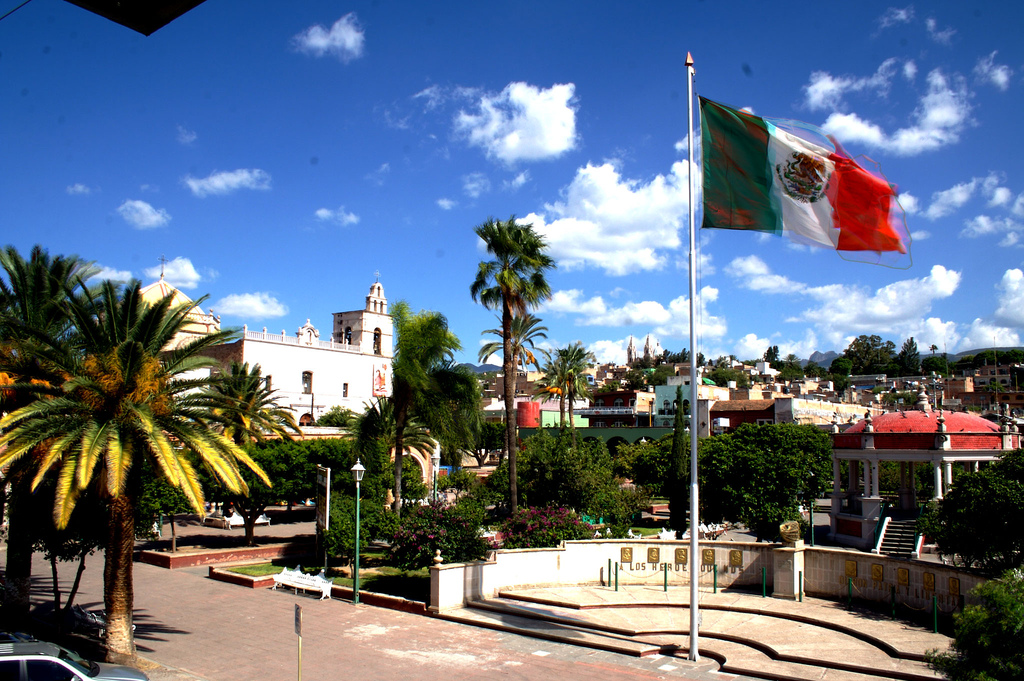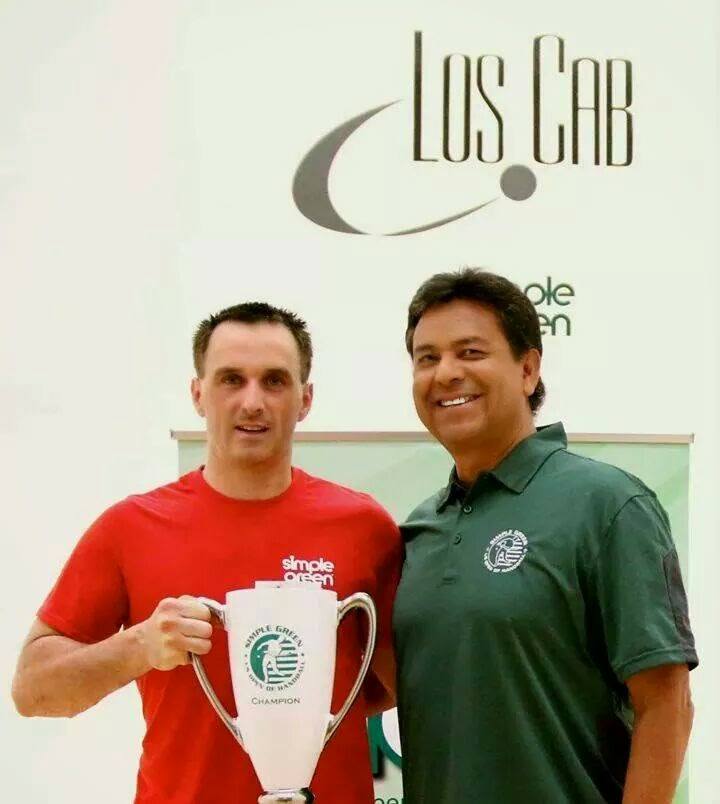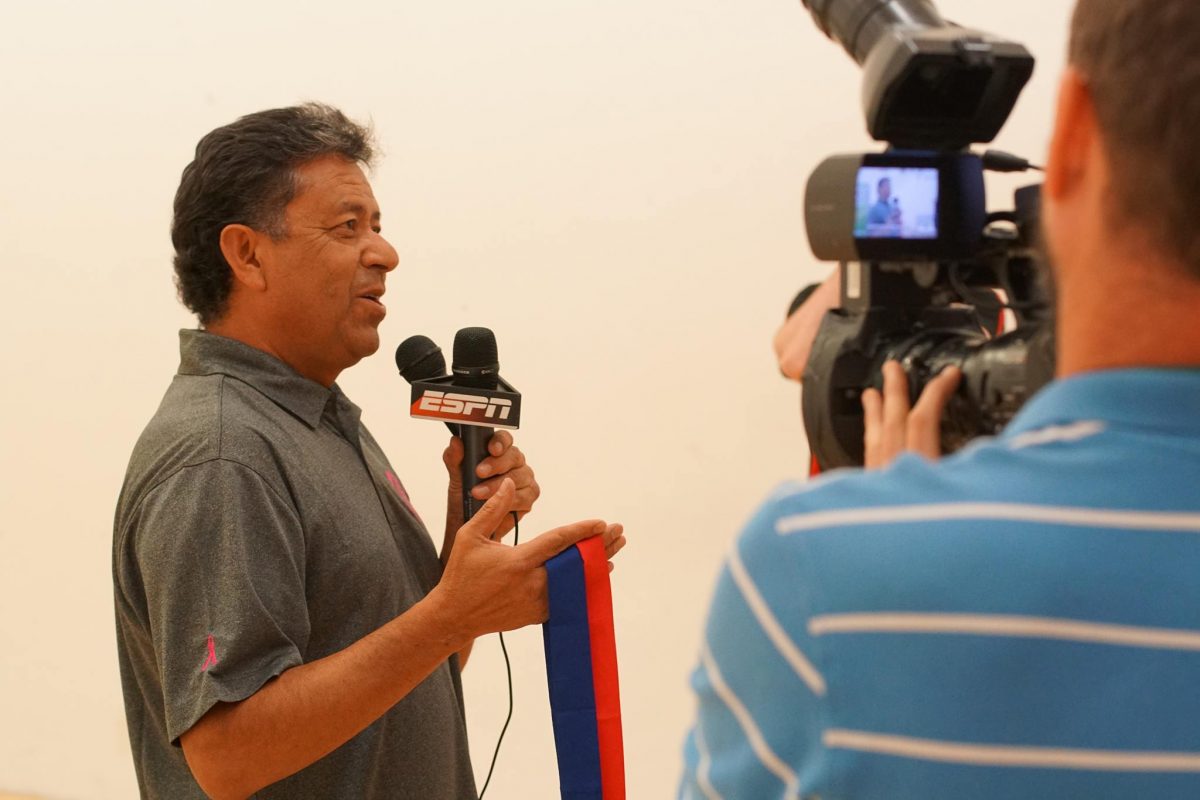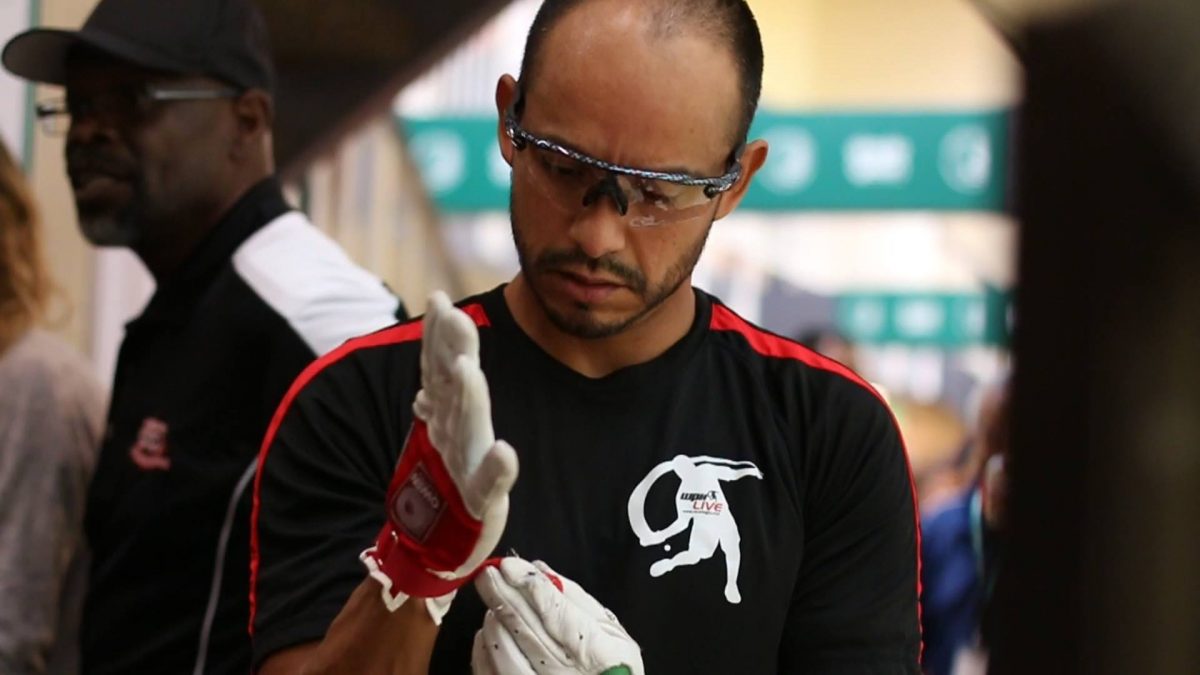By David Fink (This interview was first published to Patreon.com/wphlive back in May of 2020. If you want breaking news, rare interviews, and handball exclusive content DAILY, then become a WPH Patreon Pledge supporter)
The WPH’s David Fink had a chance to relive history with Naty Alvarado, Sr., one of the greatest handball players of all time. Naty discussed everything from his start in the game, his family, his greatest rivals, his most important wins, watching his son play, his most difficult matches and so much more. Naty provides us with a glimpse into greatness in this can’t miss interview.
Naty Alvardo Sr. is synonymous with greatness in handball, as “El Gato” dominated the sport for more than a decade with grace, power, humility, and class. Alvarado Sr. ushered in a new era of pro handball, taking two-handed offense, power, and aggressiveness to the forefront of the sport and reshaping the game for generations to come. El Gato won 63 USHA Spalding/Gatorade Pro Stops, retired with a then record 11 USHA 4-Wall pro singles titles, teamed with Vern Roberts to dominate 3-Wall and 4-Wall national doubles and won hundreds of weekend tournaments.
Alvarado retired from professional handball at the age of 36 and quickly transitioned into one of the sport’s greatest ambassadors and promoters. Alvarado teamed with good friend Mr. Bruce FaBrizio and Simple Green to host the Simple Green U.S. Open of Handball in Southern California, combining 4-Wall, 3-Wall, and 1-Wall handball to create handball’s Super Bowl every October for more than a decade. More important than all of his titles and his passion for growing the game was always El Gato’s family, who all live within walking distance of him today in Hesperia, CA.
Naty Alvarado, Sr. has long been one of handball’s most likeable and respected champions and handball’s greatest champion was kind enough to sit down with the WPH in a wide-ranging four part interview discussing his start in the game, his greatest rivals, his breakthrough moment, his move from Mexico to California, his coaches and mentors, his early learning experiences, his inspirations, his biggest career wins, his training routine, his handball heroes, stepping away from the pro tour, growing the game, watching his son Naty Jr. rise to the top of the sport, the Simple Green U.S. Open and much more in this blockbuster conversation.
You’ve seen The Last Dance, now relive handball through the 20th century’s greatest player in Chasing Down El Gato.
You’ve had more great moments on the court that probably anyone ever. What was your best moment on the court?
Maybe by now we all probably know the Pro Stop in Tucson to me is memorable because of the timing of it. Before we decided to move to Southern CA, I borrowed money from a few of my friends. The names that come to mind are Memo Correa, Elias Carrillo, Antonio Monreal, Chuy Burrola, Richie Fernandez and especially Naty Gonzalez. They all gathered some funds to help my move to Southern California. When it was time to play in the qualifier at the Tucson Pro Stop tournament I was diving, digging, and I played my heart out. When I won my first Pro Stop all my hard work had paid off. It was an unforgettable feeling I felt that day.
As soon as I got to Pomona, CA I cashed my winnings and sent them their respective monies that they raised for me. How can I ever thank them for their faith and belief they had in me.
Could you describe what it was like to win your first national 4-Wall singles title?
At the 1977 USHA Nationals in St Louis I had been on the Pro Tour for about a year and I knew I wanted to win national titles but I was not really sure when that would happen. I had won some Pro Stops but the Nationals is what everybody shoots for and trains for. By winning the Nationals it becomes a reality. It’s a way to say, ‘hey I can do this,’ so winning my first Nationals was a way to say, ‘hey I can do this, I have worked for it.’ I realized that I could win more but you have to commit in order to do so.
What was your biggest career win?
Atlanta, GA USHA Nationals 1990.
After losing in early 1989 on the Pro Tour season and losing in Chicago at 1989 Nationals to Poncho Monreal and losing during all the 1990 season on the Pro Tour I gave myself a very good training year. Every time I lost in a Pro Stop I was training the next day – running, another day weights, another day bicycling, weekends hiking and practicing handball in between. All of this came together during the Nationals week in Atlanta when I made the finals against Jon Kendler.
What was your biggest disappointment on the court?
When I was 15 years old at The Banos Roma I played a game for $10. I spotted a player 20 points as a handicap. There was no room for error. I lost like 14-21 and the losing feeling was awful. I did not have the $10 I had bet in my wallet, so I promised myself to learn from that. Handicapping was a major component of betting and after that experience I never gave anyone 20 points again.
I guess my opponent saw that the feeling I was having and he did not ask for the money we bet. He also advised me to be careful in my future ventures with betting but the damage was done. I have never felt that way again, even when I lost on Pro Stops or Nationals. I still remember that afternoon, I just can’t put a name to that face but I have never forgotten him.
You won 11 USHA National Four Wall Championships, a record that stood until Paul Brady tied you in June of 2019. Is there one or two of those titles that stands out more than the others and why?
After losing at the Chicago Nationals in 1981, I went home and trained like never before. I always trained my whole career but the summer of 1981 was special. I was motivated to become a better player at that time. I played Fred Lewis in an exhibition for Voit, the handball I was advertising. There was a $5000 winner take all and Fred beat me.
After the match we went to Lou Morales’s house for dinner. I was sitting there on a couch, quiet and sad thinking what I did wrong during the game. A gentleman sat down and introduced himself as Richard Pohlmann. He told me after a brief conversation to meet him at his office the next day. I did and he ended up hiring me to work with him selling life insurance for Equitable of Iowa.
That summer I was making money in another way and not relying solely on my handball game alone. In the 1982 season, I was on a mission and playing more relaxed than ever in the handball court. I was able to choose my shots and not kill myself reaching for every shot of every rally, so I was a lot more relaxed and making better decisions on my shot selection.
The 1982 USHA Nationals was the first of my titles where I could finally step in the court with a lot more confidence. I was in one of my best shape ever due to my training, I was more relaxed due to my job with Richard and Equitable, and I was 26 years old and I was more mature.
You were one of the mentally strongest players in history. Jaime Parades recalls you winning one of your 11 national 4-Wall titles with one arm because of a bad elbow. How did you develop that mental toughness? Can it be learned?
What a great timing for this question, can it be learned.
I guess life dictates your destiny’s triumphs and it’s up to you to achieve them. In my case, getting married at 17 with two kids at 18 years old and wanting to be the best player in handball, I had the need to win to feed my family because the only thing going for my success was my skill to play the game. I dedicated my body to training, working out and getting in the best shape I could to be able to play without getting tired and outlasting my adversaries in tough close matches. I used my mind to learn and improve as much as I could by practicing a variety of shots so when I was in a close match, I had the confidence to execute what I had practiced many times.
To obtain my goals I set earlier to have a good handball career, the will to win probably came with my lifestyle. I was growing up and my experiences in life and my wins and losses (mostly my losses) taught me how to cope with my future matches. The feeling of losing left such a bad taste in my soul and it made me just a little bit tougher. The mental state achieved by focusing and my awareness of being conscious of my situation in order to win it helped improve my mindfulness.
Or was it the genes passed to me from my ancestors all along? I thought my father was the reason for my handball skills but he was not the greatest player out there. My father was a good athlete and played all the sports I mentioned before but he was not a good handball player. Just about 10 years ago I learned that my mother’s father was a very good Fronton player (handball being played outdoors with a front wall and left side wall) and made his living playing it in Jimenez and Camargo in Chihuahua Mexico in the early 1900’s. How he got his skills, maybe the Aztecs or Toltecs. All I know that I took advantage of it and trained to become who I was. I had a lot of help from different people in my life from the beginning until the end of my career.
Who was your greatest rival during your pro tour career and why?
My greatest rival was without a doubt my teacher, Fred Lewis. Fred was the biggest influence in my life. He was the person that made me improve the most. Because of Fred I developed my ceiling and passing game. Fred was the reason I practiced so much and got in the best shape I could. I knew that whenever I had to play him I was going to do most of the running.
Who gave you the most difficult matches throughout your career?
Fred Lewis made me give all I could handle and more during a match. It was mental and physical every time I had to play him. He would surprise me with his tactical style of play. At the beginning he would pass me and play the ceiling game. After I practiced those two particular shots I could stay with him during the match, but then he would come out shooting more than the usual, throwing me out of sync. We had some great matches.
Vern Roberts was another player who I had some tough matches against 3 wall and 4 wall he’s someone special in my career playing doubles with him it made me a better player and without him there is no way I could have won those titles.
What do you consider your peak years?
I had a great run from 1982 to 1988. I was able to alternate my training. Handball practicing, running, bicycling, hiking, weight lifting repetition four days a week and playing handball twice a day three times a week when getting ready for a tournament without getting hurt, especially for the Nationals.
Did you employ different game plans against different opponents, or were you more focused on playing your game?
Late in my career I did play some players differently than my style, picking more on their weaknesses, but at the beginning I had to learn other styles of play. In the majority of my career I played primarily my style of more shooting than passing and attacking more. That style required more physical ability in order to shoot the ball continuously because you have to set up properly and use your legs more in order to successfully play that style. When you get older you can’t shoot the ball as much. Fortunately I took handball seriously and trained hard my whole career to adapt.
What type of training did you employ during your run as the top player on the planet?
At the beginning of my career I did the basics – running, calisthenics and a lot of playing handball, mostly doubles before coming to California. I played my two friends Memo Correa and Elias Carrillo in very heated two-on-one competitions for about a year and a half. They beat me a lot in the first six months, we traded wins for the next six months then it was my turn for the last six months. Handball training was one of the reasons for me to move here to the U. S.
When I was here in Southern California there were more doubles than singles. When I went to my Pro Stops it was easier for me playing against one person.
In the late 70’s I kept to playing doubles and running but incorporated the Nautilus machines. In the 80’s I incorporated biking and hiking and 200 meters sprints and playing twice a day for three days and practicing certain shots in the handball court. All this training allowed me to get stronger as the tournaments went on, so yes I took my profession very serious.
How many tournaments did you play per year during your reign atop the world?
I would say about every other week, counting tournaments and exhibitions. At one point I was playing doubles with my friend Bobby Diaz RIP in a regional tournament in Long Beach CA. Right after my semifinals, Pete Engler, a handball player with his pilot license flew me to Fresno CA to play an exhibition match against Fred Lewis. So yes, I was busy then and loved every moment of it.
Who was your toughest opponent on the tour?
Of course it was Fred Lewis. Fred really tested me for eight years. We were very competitive. He won in 1976, 1978 and 1981 while both of us were in our prime. By 1983 we had another three-game match in Houston.
Who was your handball hero?
Renato Almonte was by far the best player in Juarez and he inspired me in different ways. He was a natural player. He was an outdoor player and he was the best without practicing or training for indoors. He impressed me a lot when I was 15 years old and motivated me to become a better player. He also told me that whenever I had a chance to move to the USA and stay there. Renato went to Albuquerque, NM to improve his game but after a few weeks he went back to Juarez and he always regretted doing so.
What would you tell an aspiring pro player who is trying to reach the heights that you reached in pro handball?
To work hard, be smart, practice, train, and listen to your coaches or players trying to help you. Don’t take your skills for granted. Set your goals and make sure your goals are reachable goals. Write your goals down and always be thankful for those who are helping you.
How difficult was it for you to step away from the pro tour?
For about 15 years I was programmed to play at least once a month in a Pro Stop, tournament or exhibition somewhere until my body aged and my injuries wouldn’t heal as quickly. I saw this transformation in past champions and I did not want to go that way. I had promised myself a few years earlier not to embarrass my career when I started to lose to players I shouldn’t. There was no disrespect to them, but I knew to stop when I was no longer in top form to compete at a high level of play. I knew early in my handball career to embrace the years I could make a difference, so that was my motivation for my training and my desire to succeed.
I learned from the past champions, so when it was time for me I retired because unfortunately, we don’t last forever. I wanted to make a difference for as long as I could.
What do you miss most about playing pro handball?
Not playing was really hard for me the first year, especially when there was a scheduled Pro Stop and I was missing for the first time in 16 years. I knew I had to retire but it was difficult, especially when I thought I could do well. Deep in my soul, however, I knew I couldn’t win anymore. I think it was my competitive nature and the habit of being there all the previous years and the losing that was the major factor for me in retiring. I took my losses probably too hard. Those losses hurt me on the inside.
As time went by, it got easier and today I am so glad I did retire early. I was lucky to see all these aspects of the game at a young age, so my departure from the game at 36 with good health has helped me to enjoy my family, and of course my grandchildren, even more.
What is the importance of growing the game?
Handball is a very hard game to play and it should be showcased for what it is. Other athletes may use handball to improve their baseball, football, soccer, or basketball skills. Players admire our sport and respect it. I am so impressed with WPH for taking our sport to a new level of professionalism and organization that can grow our game. Future champions need to have heroes to inspire them. I know I had some.
How would you compare the style of game of the pros on the tour during your run to the pro style in today’s game?
There were a variety of styles: those who used the ceiling game, those who lob served, and those who passed more. I could be considered more of the serve-and-shoot, fly shot and pass kill style from the 70’s to the 90’s. We had several ball changes, which contributed to the style changes, black ball to the blue ball, a short-lived red, and back to blue. The balls were lively for the most part, but also got some periods of slower balls when changing manufacturers, so during that time the ceiling and pass game was used more and we adjusted. I would say my style was more of an attack and aggressive.
Which pro players do you enjoy watching on the Race 4 Eight tour today?
Unfortunately, since we stopped hosting the U. S. Open of Handball sponsored by Simple Green and Mr. Bruce FaBrizio, I have not been able to watch much. I certainly loved to watch Naty Jr., John Bike, Fred Lewis, Vince Munoz and Tati Silveyra – they had the style of play similar to mine, so I enjoyed them a lot in some different ways. I liked watching Bo Blinski, Poncho Monreal, Jon Sabo and Danny Bell. In the last 4 years, I’ve enjoyed Killian Carroll, Paul Brady, Mando Ortiz, Sean Lenning and the Cordova brothers.
Who would you have liked to play in today’s game when you were in your prime?
I’m really not interested in who was better, but I can tell you I would have loved to try these new lively current balls. I think they would have helped my serve.
How can handball players continue to improve into their 40’s and 50’s?
Those who avoided injuries in their early years and those with limited abilities who are sticking around can improve the most studying the game. Those who stayed in shape and trained to become better are the ones who can benefit the most.
Handball has always been about family for you. How satisfying is it for you that your family shared your handball journey with you every step and every title of the way?
My family knew handball was my life and for that reason their lives we were dependent on my victories. Lupe pushed me when I didn’t feel like doing it on my own. It was my dream and they wanted my dreams to come true. They were there from the beginning. Tucson was a special place for us, as we all could travel by car and stayed at Bo and Barbara Blinski’s. The USHA Nationals was a major trip for all of us – it was like playing at home. Towards the sunset of my accomplishments, Naty Jr. was there for me in Atlanta, GA for my last one. So yes, I was blessed for my family taking an interest in my beloved sport. Handball was the glue to my family and who else would I like to share it with but them!
You transitioned from the game’s greatest champion to one of the game’s greatest promoters. Teaming with Mr. Bruce FaBrizio and Simple Green, the Alvarado family led the annual Simple Green U.S. Open, bringing together all codes of handball in one location in one of the greatest weeks of every handball year. How did that tournament come together and how proud of what you, your family, and Simple Green accomplished during that incredible run of Simple Green U.S. Opens?
In 1991 Lupe and my friend Louie Rivera started the first Naty Alvarado Handball Classic in Victorville CA. We had sponsors from the local Budweiser distributor and a local Bank, so we had great support and great tournaments for 15 years until the closing of our local club in 2007 where the tournament was being held.
Mr. FaBrizio was aware of the situation with our tournament and said during one of our dinners after our regular doubles matches with Mark Shelgren Naty Jr., “If you bring your tournament to Orange County, I will sponsor your event.” With no hesitation of my part, I agreed and right away had visions of hosting the best handball tournament ever.
Because I knew of Mr. FaBrizio’s company’s professionalism and especially his and Simple Green’s way of always running the best and most professional event that there would be no doubt that we would develop a wonderful partnership. For 10 Simple Green U. S. Opens and 26 Naty Alvarado Handball Classics we can say that all of the events were greatly run. At the Simple Green U.S. Open we brought the best players in 4-Wall, 3-Wall Big Ball and 1-Wall Big Ball, creating the Festival Of Handball for ten wonderful years. I cannot thank Mr. FaBrizio and Simple Green enough for all he and his company did for handball.
You passed the torch to your son, Naty Alvarado, Jr. as you retired in your mid 30’s. Naty. Jr. would carry on the Alvarado name with pride, class, sportsmanship, and incredible play, ranking amongst the world’s best players for more than 20 years until he stepped away from the tour in 2015. Were you more nervous watching Naty Jr. Play than playing in your own championship matches?
Naty Jr. gave my entire family and I some wonderful years of excitement and thrills. He played at the highest level of handball. His own family usually had the loudest fans when he played, but of course it was my daughter Lupita who brightened the gallery with her passion for his game for 20 years. Naty Jr. brought pride to me and to all of us in his heyday. He added 20 more years to my Handball life. How lucky can someone be? Naty Jr. was a trophy to my existence after my days as a competitor.
How much of your game did you see in Naty Jr.’s?
Everything he did was like looking in the mirror but prettier, stronger and nicer. His demeanor and approach to the game, his serve, his seriousness to train and stay on top – he was everything a father can hope for on the handball court and definitely as a son he is more than you can ask for.
You built a 3-Wall court in your back yard several years ago and it’s become a gathering spot (pre COVID-19) for your kids, grandkids, and friends. What is it like to be able to go into your backyard and play pickup doubles with your grandson against your son-in-law and son?
Incomparable. The fact that our wives, daughters, granddaughters, grandsons, and in-Laws all can play is just awesome. We usually change partners all the time when John, Naty and I play. There is an abounding amount of respect. 3-Wall Big Ball is not our sport of origin and we can live with that. Playing on the court is a family party with friends that follows food and beverages of your choice.
Our kids, family and friends have been remarkable during this pandemic coronavirus. We are practicing social distancing and with no vaccine available, we are staying home as much as possible so we can stop the virus from spreading even more so. We will do our part to keep the USA safe.
Word Association
Killian Carroll: Improving, long career ahead of him
Paul Brady: Life commitment to reach the 11 Club – congratulations
Fred Lewis: Steady Freddy, a humble champion.
David Chapman: Matured early, mental champion
Poncho Monreal: Champion and friend who pushed and helped me to 11
Danny Bell: Ageless and just getting better
Naty, thank you so much for giving the WPH the opportunity to track you down, steal your thoughts and ‘blast’ to the rest of the world. You are a very special father, handball player and mentor.
Thank you, Dave. My pleasure.
David Fink
WPH Senior Writer










